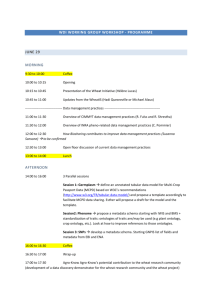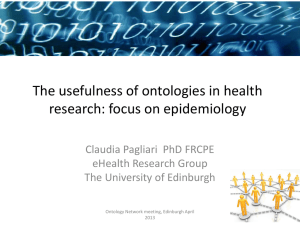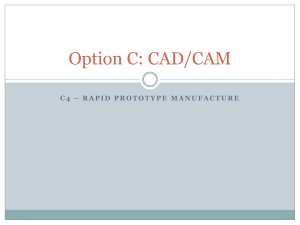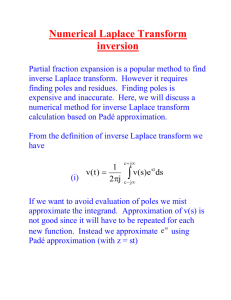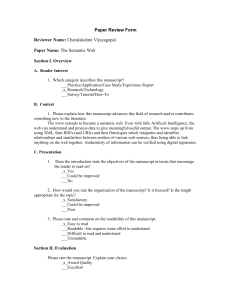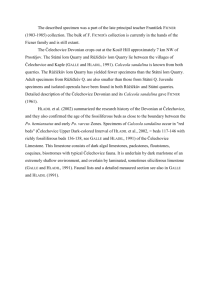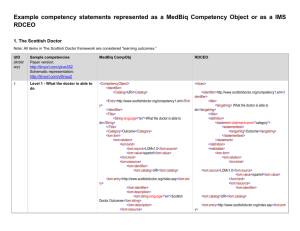46_1241838558_Phaedra_Mohammed_paper
advertisement
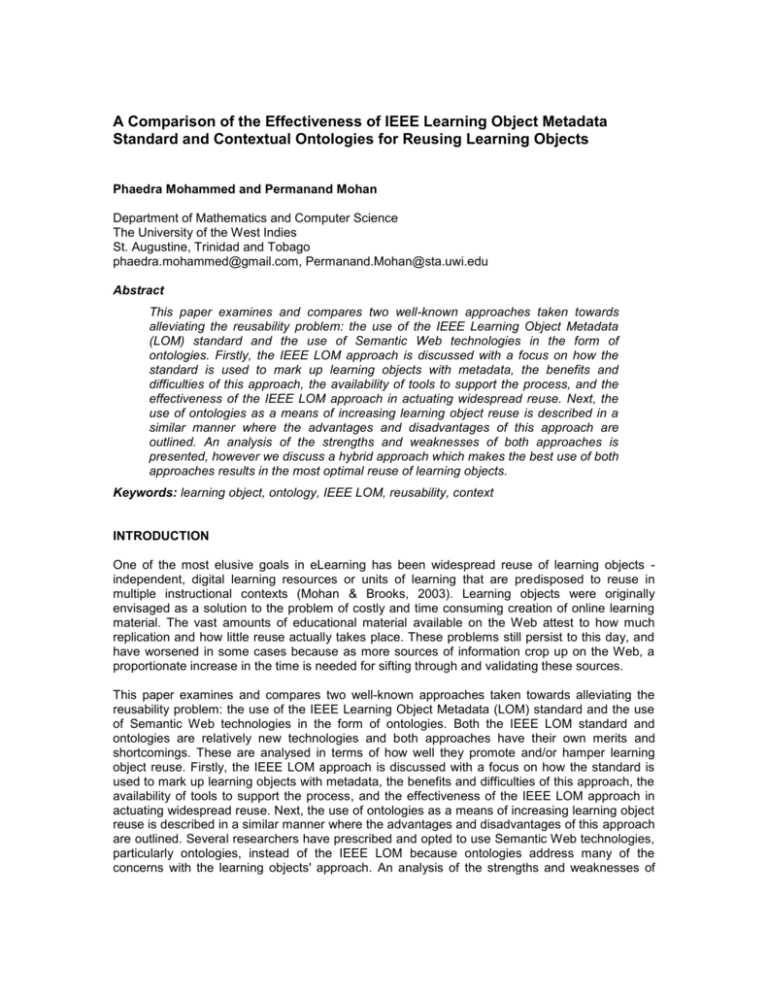
A Comparison of the Effectiveness of IEEE Learning Object Metadata
Standard and Contextual Ontologies for Reusing Learning Objects
Phaedra Mohammed and Permanand Mohan
Department of Mathematics and Computer Science
The University of the West Indies
St. Augustine, Trinidad and Tobago
phaedra.mohammed@gmail.com, Permanand.Mohan@sta.uwi.edu
Abstract
This paper examines and compares two well-known approaches taken towards
alleviating the reusability problem: the use of the IEEE Learning Object Metadata
(LOM) standard and the use of Semantic Web technologies in the form of
ontologies. Firstly, the IEEE LOM approach is discussed with a focus on how the
standard is used to mark up learning objects with metadata, the benefits and
difficulties of this approach, the availability of tools to support the process, and the
effectiveness of the IEEE LOM approach in actuating widespread reuse. Next, the
use of ontologies as a means of increasing learning object reuse is described in a
similar manner where the advantages and disadvantages of this approach are
outlined. An analysis of the strengths and weaknesses of both approaches is
presented, however we discuss a hybrid approach which makes the best use of both
approaches results in the most optimal reuse of learning objects.
Keywords: learning object, ontology, IEEE LOM, reusability, context
INTRODUCTION
One of the most elusive goals in eLearning has been widespread reuse of learning objects independent, digital learning resources or units of learning that are predisposed to reuse in
multiple instructional contexts (Mohan & Brooks, 2003). Learning objects were originally
envisaged as a solution to the problem of costly and time consuming creation of online learning
material. The vast amounts of educational material available on the Web attest to how much
replication and how little reuse actually takes place. These problems still persist to this day, and
have worsened in some cases because as more sources of information crop up on the Web, a
proportionate increase in the time is needed for sifting through and validating these sources.
This paper examines and compares two well-known approaches taken towards alleviating the
reusability problem: the use of the IEEE Learning Object Metadata (LOM) standard and the use
of Semantic Web technologies in the form of ontologies. Both the IEEE LOM standard and
ontologies are relatively new technologies and both approaches have their own merits and
shortcomings. These are analysed in terms of how well they promote and/or hamper learning
object reuse. Firstly, the IEEE LOM approach is discussed with a focus on how the standard is
used to mark up learning objects with metadata, the benefits and difficulties of this approach, the
availability of tools to support the process, and the effectiveness of the IEEE LOM approach in
actuating widespread reuse. Next, the use of ontologies as a means of increasing learning object
reuse is described in a similar manner where the advantages and disadvantages of this approach
are outlined. Several researchers have prescribed and opted to use Semantic Web technologies,
particularly ontologies, instead of the IEEE LOM because ontologies address many of the
concerns with the learning objects' approach. An analysis of the strengths and weaknesses of
both approaches is presented in the paper. Both methodologies make use of metadata, but we
show that a hybrid approach which follows the vision laid out in (Mohammed & Mohan, 2007)
makes the best use of both techniques and results in the most optimal reuse of learning objects.
REUSE WITH THE IEEE LEARNING OBJECT METADATA (LOM)
The IEEE Learning Object Metadata Standard
The IEEE 1484.12.1-2002 Standard for Learning Object Metadata (LOM) is the recognized
standard (Draft Standard 2002) that is used for marking-up learning objects although several
other cataloguing schemes exist. The LOM data model consists of nine categories of data
elements which define a structure for storing data about a learning object: General, LifeCycle,
Meta-Metadata, Technical, Educational, Rights, Relation, Annotation, and Classification. A few
tools such as Reload can be used to create the metadata and the most common implementation
language is XML.
Benefits and Drawbacks of the LOM Approach
Holzinger, Kleinberger and Müller (2001) outline some of the benefits of using the LOM. They
explain that since the LOM is an international standard, it provides a shared description of
learning objects that can be understood by computers. This means that users can discover,
manage, and share learning objects because of the machine readable metadata. Interoperability
through metadata would allow different learning systems to use the same learning objects for
different purposes. Also, they add that the LOM facilitates the creation and use of these
descriptions in a manner that is independent of the content itself, and that many of the original
intentions behind the learning object movement are enabled by using the LOM such as: dynamic
combination and decomposition of units within a learning object to create new sequences of
learning material by software agents, sharing and exchange across any computer-based learning
system (that supports the LOM), and creation of meaningful personalised lessons for individual
learners. Mohan and Greer (2003) counter that little has been achieved by using the LOM and
this is mainly due to the lack of tools for automating the markup process, insufficient expression
of semantic meaning in learning object metadata, the time-consuming manual process of filling in
the metadata elements of the LOM, and undeclared assumptions made by the authors of the
learning objects. Sharing among learning systems is still restricted since there is no set of
commonly shared tags and because the meaning of these tags are dependent on the system that
the tags were developed for. So, very good learning objects may exist for a wide range of topics
but they are only usable within the systems for which they are built. In addition, the LOM does not
cater for all types of learning objects since it is biased towards text-based learning objects over
multimedia content such as animations and videos. All of the arguments about the size and
usability of the LOM are trivial compared to the complaints about the actual elements in the LOM.
The most important problem concerning the specification is its lack of expressiveness. Since the
LOM’s organization, design and scope are deficient in capturing the various and necessary facets
of learning that a learning object is meant to represent. Essentially, the majority of these problems
stem from one main deficiency: the lack of meaningful metadata.
THE ONTOLOGICAL APPROACH TOWARDS LEARNING OBJECT REUSE
Ontologies
An ontology is defined as ‘a formal, explicit specification of a shared conceptualization’ (Fensel et
al. 2001) where formal implies that the ontology is machine-readable and explicit means that the
ontology provides a clear description of the nature and constraints of the concepts and
relationships. Shared refers to the agreement or consensus achieved with respect to the nature of
the conceptualization; it is a perception shared by a group as opposed to an individual. The
rationale behind this definition is that formally represented knowledge is based on one or more
conceptualizations (Gruber 1993). The theoretical nature of objects, concepts, and the
relationships that connect them is depicted in a conceptualization. Hence an ontology is simply a
symbolic illustration of some area of interest in the world. A few tools exist which can be used to
create ontologies such as Protégé, and several implementation languages are in active use such
as RDF, OWL, DAML+OWL, OIL (Fensel et al. 2001).
Benefits and Drawbacks of Using Ontologies
Many researchers have been associating ontologies with various aspects of a learning object
over the past three years in an effort to improve the quality of metadata and encourage reuse.
Ontologies are more expressive and less restrictive than the LOM since user-defined concepts
and relationships are encouraged. In addition, only those concepts that are pertinent to the
learning object are included in the ontological metadata unlike in the LOM where many
inapplicable tags are present. The flexibility in describing variable forms of educational multimedia
such as text, audio, animations, video, and so on is also another benefit of using ontologies.
Several ontologies can be used to describe one learning object and each one can be focused on
different areas that are important for the learning process (Mohan & Brooks 2003). Above all,
ontologies provide meaningful metadata that can be disambiguated through references to other
ontologies. Essentially, learning systems which do not recognise a piece of metadata in one
ontology can clarify the meaning by referencing another ontology which it understands. LOM
metadata is linear and cannot be used to link to another metadata representation. Despite these
benefits, there are drawbacks to using ontologies. Ontologies are just as complex as the LOM in
that tools need to be used by non-expert users when creating ontologies. Linking ontologies to a
learning object is problematic since there are many ways of associating a learning object with an
ontology and this can hamper discovery within and across repositories. Lastly, since many
ontologies can be used to describe a learning object, it is difficult to discern what aspect of a
learning object is described by particular ontology without parsing the entire ontology.
A HYBRID APPROACH: MAKING USE OF THE LOM AND ONTOLOGIES
Many of the major problems identified with the use of the LOM have been addressed by the use
of ontologies. However, the ontological approach introduces problems of its own and these must
be addressed before any widespread reuse takes place. Mohammed and Mohan (2007)
prescribe a methodology for resolving these issues by combining the best qualities of both
approaches. They explain that ontologies represent the context of learning objects since they
clarify the meaning and circumstances of usage surrounding educational materials. In particular,
five major categories of context were identified namely: thematic, pedagogical, organisational,
learner-related, and historical/statistical. These categories reflect different dimensions of learning
objects which are important for successful reuse of learning objects in new instructional scenarios
and details are given in Table 1 below. A semantic metadata model was proposed which provides
a means of categorising and linking these multiple contextual descriptions (ontologies) to a
learning object’s physical files and explicitly illustrates how the connections between the learning
objects and the ontologies are made using the LOM. By making use of the Classification, taxon
and taxonpath tags within the LOM, this approach shows that many ontologies with meaningful,
rich metadata can be attached to the LOM and the type of ontology is identified using these tags
so that searching within the ontological metadata is not necessary. The LOM is in turn attached to
the learning object in a standardised way thereby providing consistent access to the ontologies.
Table 1. The major parameters of context for a learning object (Mohammed & Mohan 2007)
Category
Thematic
Pedagogical
Organisational/
Structural
Learner
Historical/
Statistical
Parameters
Domain Topics, Core Topics, Equivalent Topics, Alternate Topics,
Difficulty Levels, Subsumption Relationships, Aggregate Relationships,
Prerequisite Relationships
Learning Outcomes, Learning Activities, Learning Techniques,
Teaching Styles, Instructional Goals, Instructional Plan, Sequence of
Topics
Type of files, Attributes of files, Instructional Roles, Components of
Learning objects,
Expected Learning style, Expected knowledge level, Expected mastery
level of topics, Expected learning goals, Expected technical devices,
Expected device specification
Learner experiences: { Learner opinion, Learner preferences, Learner
evaluation, Learner access patterns, Learner test results, Date of
usage, Learner characteristics}
CONCLUSIONS
Learning objects are essential to E-Learning because they are the currency of educational
systems. The hybrid approach is practical since it makes use of the LOM specification in its
current state. It gives a simple yet effective method for describing any facet of a learning object,
be it about the domain, the instructional style, and the organization of the learning object’s
structure or even about the learners that used the learning object. The learning objects that follow
this approach to metadata enhancement can be used by any system that already works with the
LOM standards since no new elements were added and this approach provides a concrete
method for realising the learning object vision of dynamic, personalised learning anywhere and
anytime.
REFERENCES
‘Draft Standard for Learning Object Metadata’ [online], 15 July 2002, accessed 28 April 2005, from: <
http://ltsc.ieee.org/wg12/files/LOM_1484_12_1_v1_Final_Draft.pdf >.
Fensel, D, Van Harmelan, F, Horrocks I, McGuinness, DL & Patel-Schneider, P 2001, ‘OIL: an ontology
infrastructure for the Semantic Web’, IEEE Intelligent Systems, vol.16, issue 2, pp. 38-45.
Gruber, TR 1993, ‘A translation approach to portable ontologies’, Knowledge Acquisition, vol.5, issue 2, pp.
199-220.
Holzinger, A, Kleinberger, T & Müller, P 2001, ‘Multimedia Learning Systems based on IEEE Learning
Object Metadata (LOM)’, in C Montgomerie, J Viteli (eds.), Proceedings of World Conference on Educational
Multimedia, Hypermedia and Telecommunications 2001, pp. 772-777.
Mohammed, P & Mohan, P 2007, ‘Contextualising Learning Objects using Ontologies’, Computational
Intelligence, vol. 23, issue 3, pp. 339-355.
Mohan, P & Brooks, C 2003, ‘Learning Objects on the Semantic Web’, in V Devedzic, J Spector, D
Sampson, Kinshuk (eds.), Advanced Learning Technologies: Technology Enhanced Learning, Athens,
Greece, July 9-11, 2003, pp. 195-199.
Mohan, P & Greer, J 2003, ‘Reusable Learning Objects: Current Status and Future Directions’, in D Lassner,
C McNaught (eds.), Proceedings of World Conference on Educational Multimedia, Hypermedia and
Telecommunications, Hawaii, June 24-28, 2003, pp.257-264.

